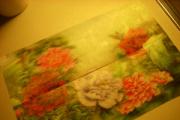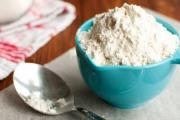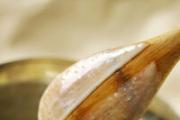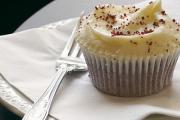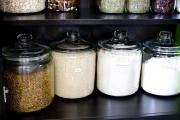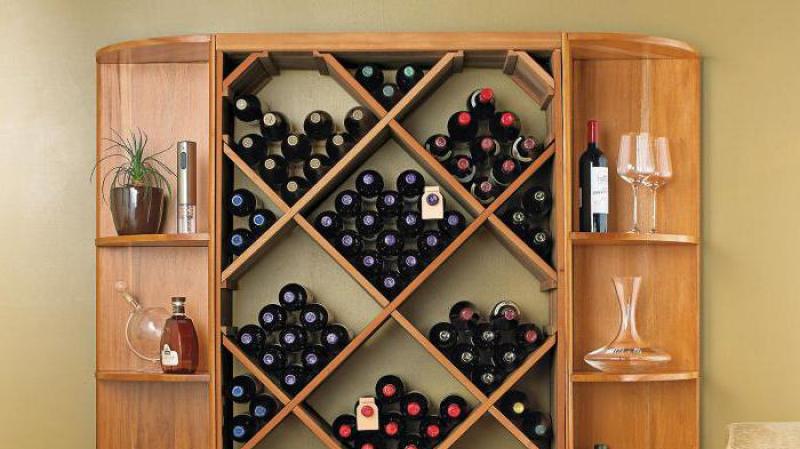Spring chocolate cake with snowdrops. Master classes for decorating cakes Cake with snowdrops from mastic
The calendar spring is about to come, but the real one already wants. So I decided to make a spring cake decorated with flowers. I'll show you the cake a little later. And today I will share a lesson on how to make a daffodil and snowdrop from mastic. This will be a very big post with very very large number of photos. I wanted to show the process in as much detail as possible so that, if desired, everything could be repeated at home myself.
Let's start with the tools. We need:
- wire
- tape tape
- scissors
- stacks
- floral or universal mastic
- pastry glue or water
- dye
- semolina
The snowdrop is made on one wire. For it, we need to make the middle / stamens, 3 small inner petals, 3 large outer petals, a sepal, a stem and a small leaf. The mastic will need three colors: light yellow, white and green.
We cut the wire to the desired length and make a small loop at the end.

Then we make a small ball of light yellow mastic. We put it on and roll it over the entire length of the loop.

Using scissors, carefully cut the upper part into 4 halves.

This is our middle / stamens. Press a little of the stamens together.

Leave it aside to dry for now. So we repeat as many times as you want to get flowers. Now take the white mastic and roll a small drop for the inner sheet. We will flatten it and thin it with our fingers.


We wrap the middle with the resulting leaf. And create 2 more of these petals.


There is an alternative way to create a small inner petal. To do this, you need a mold as in the photo. You need to roll out the mastic thinly, cut out the shape and cut into segments.

A ball stack can be finished over the edges if desired.

And then also attach to the middle. I like this method more, and it turns out much faster. We send to dry again.

Now the outer large petals. Here we need a larger drop, we also flatten it, but now we are working with a stack with a ball.

Roll the petal in the middle. Should get a boat shape.


One end should remain pointed. You will need 3 petals.

The inner petals should be tinted green. But not entirely, but only the hollow itself.

Almost the final assembly of the flower. Fastening the outer petals. Lubricate the lower part with water or confectionery glue.

And we apply it to the middle. The inner part should, as it were, sink into this boat shape.

We attach the remaining petals in this way. Again, just one flower - 3 large petals.

The main rule when working with mastic is to immediately give the desired shape to the product so that it hardens so. Because then nothing can be fixed. Therefore, we dry the flowers with the "head" down. At the same moment, you can set the degree of flower opening.

Let's move on to the sepal. We make a small green ball.

With a toothpick and a stack, pierce in the middle half the thickness and roll out the edges. It turns out such a small cup.



We pierce with a wire, which already has our flower and stretch it to the top.

The stem remains. Roll out a thin sausage and flatten it.

Put a flower on top and press it in.

Then we pinch the edges and roll it a little to hide the seam on the stem.


For a leaf, we make a small drop of green mastic, roll it with a stack and attach it to the bend with water or glue.

After the flower was dry, I toned the stem to make it come out more naturalistic. For this I used green and black pollen. The snowdrop is ready.



Now let's move on to the daffodil. I will be making yellow daffodils, so I will need two colors of mastic: light yellow for the stamens and pistils, and bright yellow for the petals. Here I will make the stem out of wire, wrapping it with tape.
Narcis consists of a pistil, 6 stamens, a central crown and 6 petals.

For the stamens and pistil, you need seven small wires. I will only do 3 daffodils. Accordingly, I need to make 3 pistils and 18 stamens.
So, we make small droplets of light yellow mastic. We put them on wires and roll them out a little. At the pistil we make a small ball at the end, flattening the top. And we bend the stamens at an angle.





Set aside for the time being to dry, move on to the central "crown". It is made according to the principle of a snowdrop sepal, only of a larger size. We need to roll up the cylinder, poke it halfway in the center and start rolling out the edges. I will roll it with a toothpick, and then with a curly stack to give relief to the edges.




Then, with my hands, I add the curves and send them off while drying.

Let's move on to the petals. Insert the wire into the center of a small piece of mastic and roll it out thinly. In this way, we will hide the wire in the middle of the petal. Cut out the petal with a mold.


Use silicone molds to add texture.


We make a slight sharpening in the upper part in the middle. The edges can be treated with a ball stack.


Having given the desired shape to the petals, we send them to dry.
We fasten the stamens and pistil together. To do this, you need a tape tape. Its main property is that it becomes sticky when stretched. We wind the parts together. Pistil in the center, stamens around.



Then we pierce the central "crown" and lower the middle down. We need to hide the traces of wire and tape, so we omit until everything is hidden.



At the petal, bend the wire at the base at the desired angle and fasten it with a tepe-tape to the stamens with a "crown". First, we attach 3 petals, and then three more between them. The daffodil is ready.









We take a wire (I have No. 22), the length of the wire is equal to the length of the future flower. We twist a small loop at the end.
We paint the porcelain yellow, sculpt a ball with a diameter of about 1 cm and put it on a wire (we pre-grease the loop with PVA glue):

We make as many balls as we want to dazzle with flowers (don't forget about the buds).
While our balls are drying up, we have "fun" - we need to roll a lot of small, small balls (in the photo they are taken with a high magnification):

Lubricate the top of the balls with PVA glue and stick with our "kids":

For balls, from which buds will later be made - this should not be done.
Now we proceed to the stamens. If someone has ready-made stamens, great (it is better to choose elongated ones). I did them as follows. We take a thin fishing line, wrap 100 circles around the thumb, carefully remove it, tie it on one side and cut it on the other, that is, it turns out this is a bubo
We spread it evenly and apply it to the lower part of the ball greased with PVA glue, trying to evenly distribute the fishing line in a circle. For strength, you can stick a thin circle of porcelain on the bottom and smooth it out well. If necessary, cut off the excess length. Dip the tips in PVA and colored sand (semolina). Here's what happened as a result:

Around (even rather between) these stamens there are still a small number of very small petals. We sculpt them like this:


And then carefully glue them around the core:

Well, the most joyful thing for many is that stamens are needed only for more open flowers.
Now you can start sculpting the petals.
I want to draw your attention to the fact that the petals of the swimsuit do not grow in a circle, but in a spiral (this is very important). There are 4 petals in one loop. Each flower has 4-5 turns. The petals of each subsequent loop are slightly larger than the previous one.
So, for the first row of petals, we take four balls of the same size (about 0.5 cm in diameter)

With our fingers we form such a droplet from each ball:

If you have boats of different sizes of droplets - great, you can roll out the layer and cut out the petals with boats
We invoice (I took a rose petal mold):

Then we put the petal on dense foam rubber (or another fairly soft surface) and begin to form the petal with a ball stack. In this case, the palm is not very convenient, you need to achieve a large bulge, and the "pattern" of the palm in this case is useless:

Here's a petal that should turn out:

Now we start gluing the petals. Remember the spiral. I draw your attention once again to this because if you try to glue 4 petals in a circle, you will not get the desired flower shape:



Here's a flower:

Our buds also need to be covered with petals:

But now you have to work hard! Sounds intimidating?
Let's get down to the leaves!
I envy the white envy of those who have suitable boats. Alas, I don't have it yet, so I'll have to pick up scissors.
We roll out a layer of green porcelain, cut out such a blank with scissors:

We cut out the cloves with scissors, roll up the edges with a stack:

We will invoice on a standard mold:

Here's a leaf turned out. Subsequently, during assembly, you can cut the lower part with scissors so that it is thinner:

We make such leaves in different sizes - large and small.
In fact, this is only a part of the leaflet! Each leaflet consists of five such parts. Therefore, you need to make leaves of each size in multiples of five.
Dry:

When they dry up, we glue the wire (the procedure is standard, I will not describe it, everything is clear in the photo):


Do not be confused by the color, when the wire dries up - it will be with a leaf of the same color:

Now you can start assembling leaves and flowers
As I said above, there are five petals in each leaf, which we fasten with a tape:

Then we roll the stem, be sure to grease the base of the lower part of the sheet with PVA glue:

It is a separate leaf on its own stem.
At the swimsuit, the leaves still grow right around the flower stem.
In the photos below, you can see the possible options for assembling flowers with leaves:



After assembly, we slightly tint the outer petals (I used oil paints):
Light green bloom and slightly brown at the edge of the outer petals.
These are the kind of swimsuits that now grow in my house:




